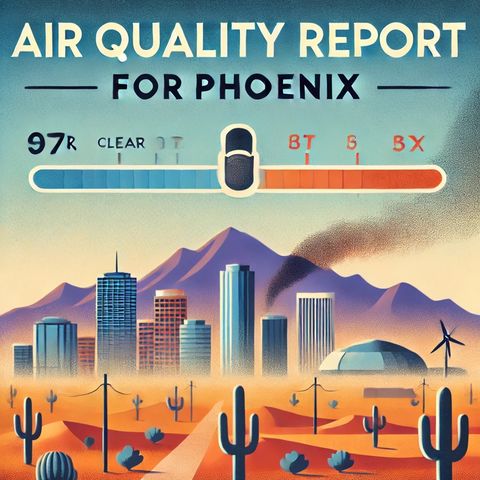Phoenix Struggles with Air Quality Challenges: Desert Climate and Trapped Pollutants Contribute to Smog and Particulate Matter Issues

Descarga y escucha en cualquier lugar
Descarga tus episodios favoritos y disfrútalos, ¡dondequiera que estés! Regístrate o inicia sesión ahora para acceder a la escucha sin conexión.
Phoenix Struggles with Air Quality Challenges: Desert Climate and Trapped Pollutants Contribute to Smog and Particulate Matter Issues
Esta transcripción es generada automáticamente. Ten en cuenta que no se garantiza una precisión absoluta.
Descripción
I'm unable to search the internet in real-time, but I can provide general information about air quality in Phoenix based on historical data and common trends. Phoenix, Arizona, often grapples...
mostra másPhoenix typically experiences higher levels of air pollution during the warmer months. This is largely due to the increased temperatures that promote the formation of ground-level ozone, a major component of smog. Ozone levels tend to rise on hot, sunny days, which are prevalent in Phoenix's desert climate. Ground-level ozone can cause various health problems, particularly for vulnerable populations such as children, the elderly, and those with pre-existing respiratory conditions.
Particulate matter, especially PM2.5 and PM10, is another significant concern. These particles are tiny enough to be inhaled and can cause or exacerbate respiratory and cardiovascular issues. Sources of particulate matter in Phoenix include vehicle emissions, industrial activities, construction, and windblown dust from the surrounding desert. Dust storms, or haboobs, can occur, particularly in the summer months, leading to sudden spikes in particulate matter concentrations.
To combat air quality issues, Phoenix has implemented various strategies such as promoting public transportation, encouraging carpooling, and implementing dust control measures. The city also provides daily air quality forecasts to help residents plan their outdoor activities accordingly. These forecasts are crucial, as they can inform people about potential health risks and suggest precautionary measures.
For specific, up-to-date information on Phoenix's air quality, residents can refer to resources like the Arizona Department of Environmental Quality or national platforms like AirNow. These sources provide accurate data on air pollution levels and forecasts, along with health advisories and recommendations.
Understanding air quality trends in Phoenix is important for both short-term health precautions and long-term environmental planning. As urban development continues and climate patterns shift, the city must remain proactive in its efforts to improve air quality and protect the health of its residents.
Información
| Autor | QP-5 |
| Organización | William Corbin |
| Página web | - |
| Etiquetas |
Copyright 2024 - Spreaker Inc. an iHeartMedia Company
